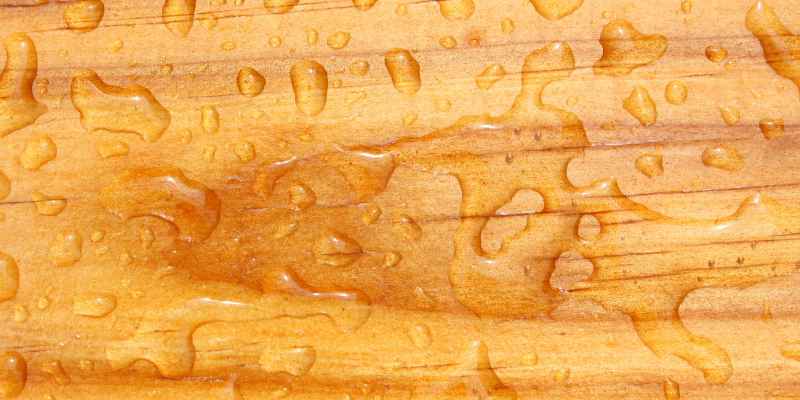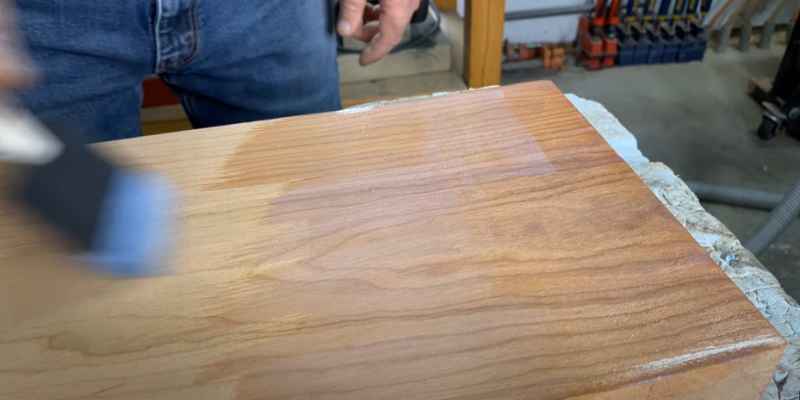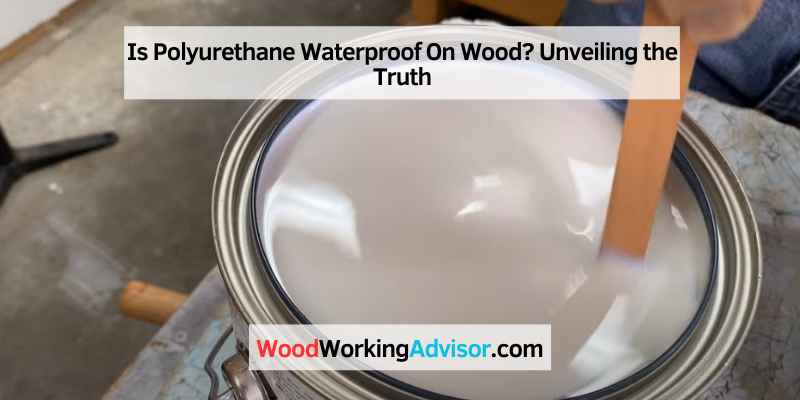Polyurethane is waterproof on wood and provides an effective protective layer against moisture. When applied correctly, it forms a durable barrier that prevents water penetration and protects the wood from damage.
With its water-resistant properties, polyurethane is an ideal choice for sealing and finishing wooden surfaces.
What Is Polyurethane?
Polyurethane is a versatile coating for wood that offers excellent waterproofing properties. It forms a protective barrier that prevents water damage and ensures durability.
Polyurethane is a versatile and popular synthetic material used for various applications, including sealing and protecting wood surfaces. It is a type of polymer composed of organic units connected by carbamate (urethane) links. This chemical composition gives polyurethane its exceptional durability and resistance to wear and tear.
Composition
Polyurethane is formed by combining two main components: polyol and isocyanate. Polyol is an alcohol-based compound that contains multiple hydroxyl groups, while isocyanate is an organic compound containing the isocyanate (NCO) group. The two components undergo a chemical reaction known as polymerization, resulting in the formation of polyurethane.
Properties
Polyurethane exhibits several desirable properties that make it an ideal waterproof coating for wood:
- Durability: Polyurethane creates a tough and resilient protective layer that can withstand physical and environmental stressors.
- Water resistance: Due to its chemical structure, polyurethane is inherently resistant to water penetration, preventing moisture from seeping into the wood and causing damage.
- Chemical resistance: Polyurethane provides protection against various chemicals and solvents, making it suitable for use in different environments.
- UV resistance: Certain types of polyurethane offer excellent resistance to ultraviolet (UV) radiation, preventing discoloration and degradation of the wood caused by prolonged exposure to sunlight.
- Enhanced aesthetics: Polyurethane coatings can enhance the natural beauty of wood by adding a glossy or matte finish, while also enriching the wood’s color and grain.
When applied correctly, polyurethane forms a protective barrier on wood surfaces, ensuring long-lasting waterproofing and preservation. It acts as a sealant, preventing water and other liquids from seeping into the wood and causing warping, rotting, or swelling.
Conclusion
Polyurethane is a durable and water-resistant coating that offers effective protection for wood surfaces. Its composition and properties make it an excellent choice for sealing and waterproofing wood, enhancing its longevity and aesthetic appeal. With its ability to withstand various environmental factors, polyurethane proves to be a reliable solution for preserving and maintaining the beauty of wooden objects and structures.

Is Polyurethane Waterproof?
Polyurethane is a waterproof coating commonly used on wood surfaces. It forms a protective layer that keeps the wood safe from moisture and water damage.
Understanding Waterproofing
Polyurethane is a widely used protective coating for wood surfaces due to its durability and versatility. But when it comes to waterproofing, many people wonder, “Is polyurethane waterproof?” Understanding how waterproofing works is essential to answer this question.
Waterproofing refers to the process of adding a protective barrier to a material, preventing water or moisture from seeping through. While polyurethane provides excellent protection for wood, it’s essential to understand its specific waterproofing abilities and the factors that can affect its performance.
Polyurethane’s Waterproofing Abilities
Polyurethane is considered water-resistant, but it is not entirely waterproof. It forms a protective film on the wood surface, creating a barrier against moisture, spills, and stains. This film helps to repel water and prevent it from penetrating the wood. However, over time, water can still seep through small cracks or gaps in the polyurethane layer.
It’s important to note that the level of waterproofing provided by polyurethane can vary depending on several factors. Let’s explore these factors below.
Factors Affecting Waterproofing
Several factors can affect the waterproofing abilities of polyurethane on wood surfaces:
- Application: Proper application of polyurethane is crucial for optimal waterproofing. The thickness and number of coats applied can impact its effectiveness. Multiple thin coats are often more effective than a single thick coat.
- Surface Preparation: The wood surface should be clean, dry, and free from any contaminants before applying polyurethane. Proper sanding and removing any previous coatings can provide a better bond and enhance waterproofing.
- Humidity and Temperature: Environmental conditions can affect the drying and curing process of polyurethane. It’s important to apply it in a well-ventilated area and within the recommended temperature and humidity range for optimal results.
- Quality of Polyurethane: Using a high-quality polyurethane product can significantly impact its waterproofing abilities. It’s advisable to choose a polyurethane specifically designed for outdoor or water-exposed applications for better durability and water resistance.
In conclusion, while polyurethane provides a protective layer that can repel water and offer some waterproofing, it is not entirely waterproof. Understanding how to properly apply and prepare the wood surface, as well as considering environmental factors and using high-quality products, can maximize the waterproofing abilities of polyurethane on wood.+
Application Of Polyurethane On Wood
Polyurethane application on wood provides a waterproof barrier that protects against moisture damage, making it an ideal choice for outdoor furniture and wooden structures. With its versatile properties, polyurethane ensures enhanced durability and long-lasting protection.
Preparing The Wood Surface
Before applying polyurethane on wood, it is crucial to prepare the surface properly. Remove any existing finishes and clean the wood thoroughly to remove dirt, dust, or other contaminants. Sanding the wood can help create a smooth surface by removing imperfections and opening up the wood’s pores. This will ensure better adhesion and penetration of the polyurethane to enhance the waterproofing. It is advisable to use fine-grit sandpaper and sand in the direction of the wood grain. After sanding, make sure to wipe away any dust using a clean cloth or tack cloth.
Applying Polyurethane
Once the wood surface is prepared, it is time to apply the polyurethane. Make sure to choose an appropriate polyurethane product that is specifically designed for wood surfaces. Using a high-quality brush or foam applicator, apply the polyurethane evenly and smoothly. Start from one edge and work your way across the entire surface, following the wood grain. It is essential to apply thin layers of polyurethane to achieve a uniform and durable finish. Allow each layer to dry completely before applying the next one. Refer to the product instructions for drying times.
Unordered List:
– Choose a polyurethane product formulated for wood surfaces.
– Use a high-quality brush or foam applicator for smooth application.
– Apply thin layers of polyurethane, following the wood grain.
– Allow each layer to dry completely before applying the next one.
Ensuring Waterproofing On Wood
To enhance the waterproofing capabilities of polyurethane on wood, a few additional steps can be taken. After applying several layers of polyurethane, consider sanding the surface lightly to remove any imperfections and create a smoother finish. This can help in increasing the effectiveness of the waterproofing. It is important to apply at least two to three coats of polyurethane to ensure adequate protection against water damage. Allow the final coat to dry completely and cure for the recommended time mentioned on the product instructions. This will help in maximizing the polyurethane’s waterproofing qualities and provide long-lasting protection to the wood.
Ordered List:
1. Apply several coats of polyurethane to enhance waterproofing.
2. Lightly sand the surface after applying the polyurethane layers.
3. Allow the final coat of polyurethane to dry and cure completely.

Benefits And Limitations Of Polyurethane Waterproofing On Wood
When it comes to protecting wood surfaces, polyurethane waterproofing is a popular choice. Understanding its benefits and limitations can help you make an informed decision about whether it’s the right choice for your project.
Advantages
- Polyurethane waterproofing provides an effective barrier against moisture, preventing it from penetrating the wood surface.
- It forms a protective layer that is resistant to wear and tear, making it suitable for high-traffic areas.
- The finish is durable and long-lasting, ensuring that your wood remains protected for years to come.
- It enhances the natural beauty of the wood by bringing out the richness of its grain and color.
- Applying polyurethane is relatively easy, making it a convenient option for both DIY enthusiasts and professionals.
- It dries quickly, allowing for faster completion of your project.
Disadvantages
- Polyurethane waterproofing can be prone to scratches and dents, especially on softer wood species.
- If not applied properly, it can leave a streaky or uneven finish, affecting the overall aesthetics.
- The application process can be time-consuming, requiring multiple coats and adequate drying time between each coat.
- Over time, polyurethane may yellow or darken, altering the appearance of the wood.
- It may not be suitable for outdoor applications as constant exposure to sunlight and weather conditions can degrade its protective properties.
- Removing polyurethane can be challenging and may require the use of harsh chemicals or sanding.
Considering both the advantages and disadvantages of polyurethane waterproofing on wood will help you determine whether it is the right choice for your specific project. If you decide to use it, make sure to follow the manufacturer’s instructions for application and maintenance to ensure optimal results.
Conclusion
To summarize, polyurethane is an effective waterproofing option for wood due to its durable and protective properties. It creates a strong barrier that prevents moisture from penetrating the wood, extending its lifespan. Regular maintenance and reapplication are essential for maintaining the waterproofing capabilities.
By choosing polyurethane, you can ensure the long-term protection and beauty of your wooden surfaces.


